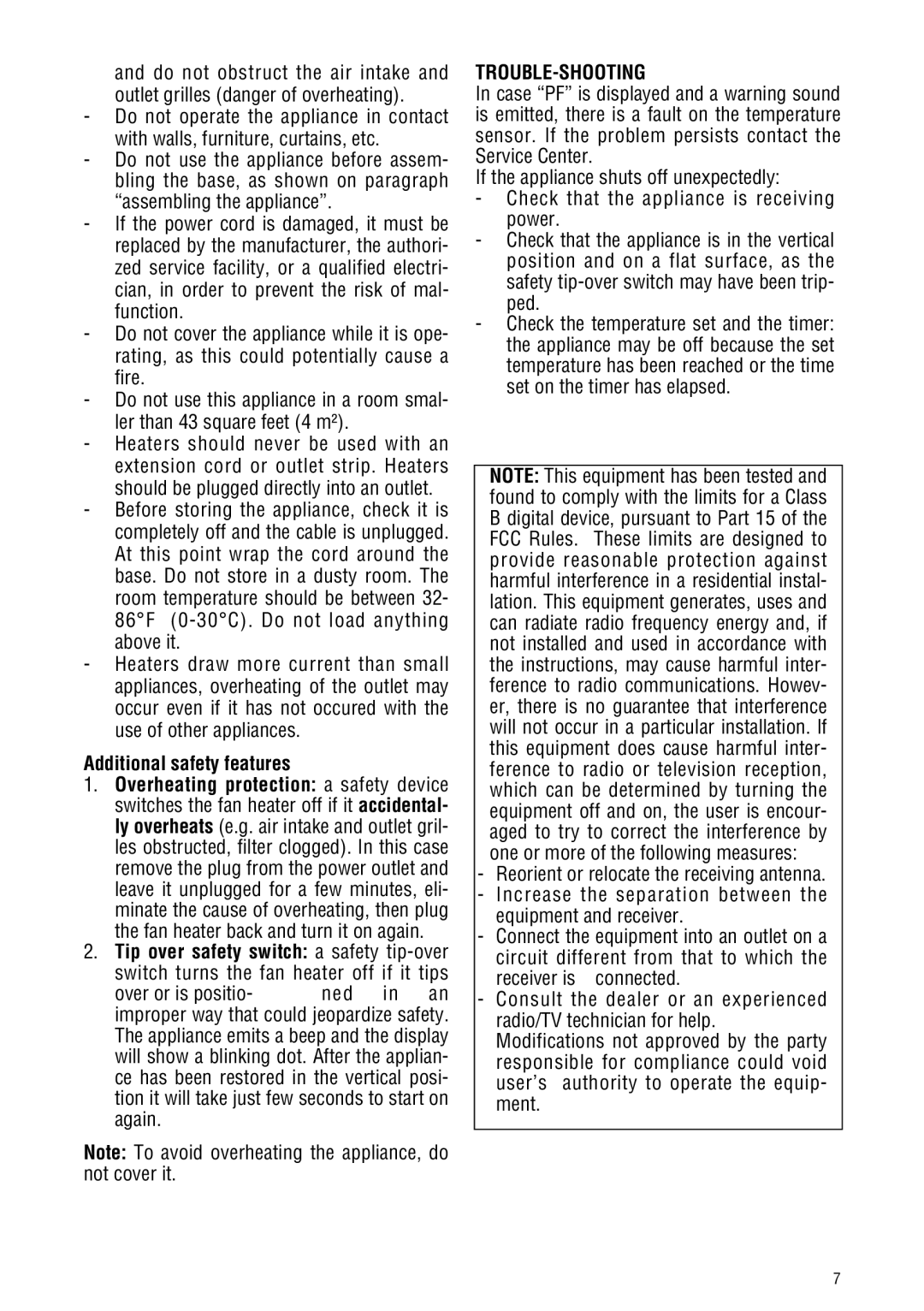| and do not obstruct the air intake and |
| ||||
| outlet grilles (danger of overheating). |
| In case “PF” is displayed and a warning sound | |||
- | Do not operate the appliance in contact | is emitted, there is a fault on the temperature | ||||
| with walls, furniture, curtains, etc. |
|
| sensor. If the problem persists contact the | ||
- | Do not use the appliance before assem- | Service Center. | ||||
| bling the base, as shown on paragraph | If the appliance shuts off unexpectedly: | ||||
| “assembling the appliance”. |
|
| - Check that the appliance is receiving | ||
- | If the power cord is damaged, it must be | power. | ||||
| replaced by the manufacturer, the authori- | - Check that the appliance is in the vertical | ||||
| zed service facility, or a qualified electri- | position and on a flat surface, as the | ||||
| safety | |||||
| cian, in order to prevent the risk of mal- | |||||
| ped. | |||||
| function. |
|
|
| ||
|
|
|
| - Check the temperature set and the timer: | ||
- | Do not cover the appliance while it is ope- | |||||
the appliance may be off because the set | ||||||
| rating, as this could potentially cause a | |||||
| temperature has been reached or the time | |||||
| fire. |
|
|
| ||
|
|
|
| set on the timer has elapsed. | ||
- | Do not use this appliance in a room smal- | |||||
| ||||||
| ler than 43 square feet (4 m²). |
|
|
| ||
- | Heaters should never be used with an |
| ||||
| extension cord or outlet strip. Heaters |
| ||||
| NOTE: This equipment has been tested and | |||||
| should be plugged directly into an outlet. | |||||
| found to comply with the limits for a Class | |||||
- | Before storing the appliance, check it is | |||||
B digital device, pursuant to Part 15 of the | ||||||
| completely off and the cable is unplugged. | |||||
| FCC Rules. These limits are designed to | |||||
| At this point wrap the cord around the | |||||
| provide reasonable protection against | |||||
| base. Do not store in a dusty room. The | harmful interference in a residential instal- | ||||
| room temperature should be between 32- | lation. This equipment generates, uses and | ||||
| 86°F | can radiate radio frequency energy and, if | ||||
| above it. |
|
|
| not installed and used in accordance with | |
- | Heaters draw more current than small | the instructions, may cause harmful inter- | ||||
| appliances, overheating of the outlet may | ference to radio communications. Howev- | ||||
| occur even if it has not occured with the | er, there is no guarantee that interference | ||||
| use of other appliances. |
|
|
| will not occur in a particular installation. lf | |
Additional safety features |
|
|
| this equipment does cause harmful inter- | ||
|
|
| ference to radio or television reception, | |||
1. | Overheating protection: a safety device | which can be determined by turning the | ||||
| switches the fan heater off if it accidental- | equipment off and on, the user is encour- | ||||
| ly overheats (e.g. air intake and outlet gril- | aged to try to correct the interference by | ||||
| les obstructed, filter clogged). In this case | one or more of the following measures: | ||||
| remove the plug from the power outlet and | - Reorient or relocate the receiving antenna. | ||||
| leave it unplugged for a few minutes, eli- | - Increase the separation between the | ||||
| minate the cause of overheating, then plug | equipment and receiver. | ||||
| the fan heater back and turn it on again. |
| - Connect the equipment into an outlet on a | |||
2. | Tip over safety switch: a safety | circuit different from that to which the | ||||
| switch turns the fan heater off if it tips | receiver is connected. | ||||
| over or is positio- | ned | in | an | - Consult the dealer or an experienced | |
| improper way that could jeopardize safety. | radio/TV technician for help. | ||||
| The appliance emits a beep and the display | Modifications not approved by the party | ||||
| will show a blinking dot. After the applian- | responsible for compliance could void | ||||
| ce has been restored in the vertical posi- | user’s authority to operate the equip- | ||||
| tion it will take just few seconds to start on | ment. | ||||
| again. |
|
|
|
| |
Note: To avoid overheating the appliance, do not cover it.
7
